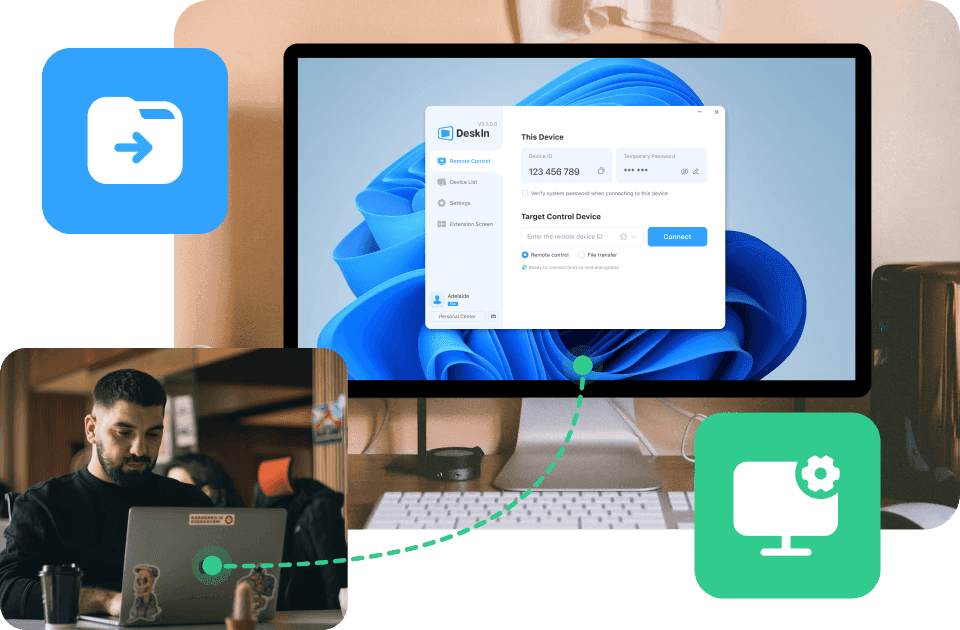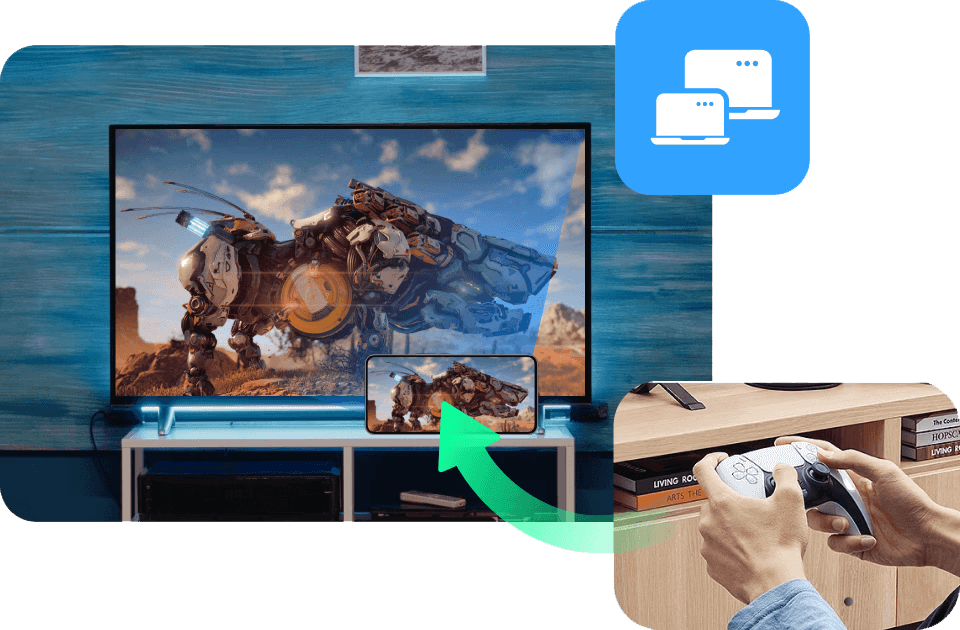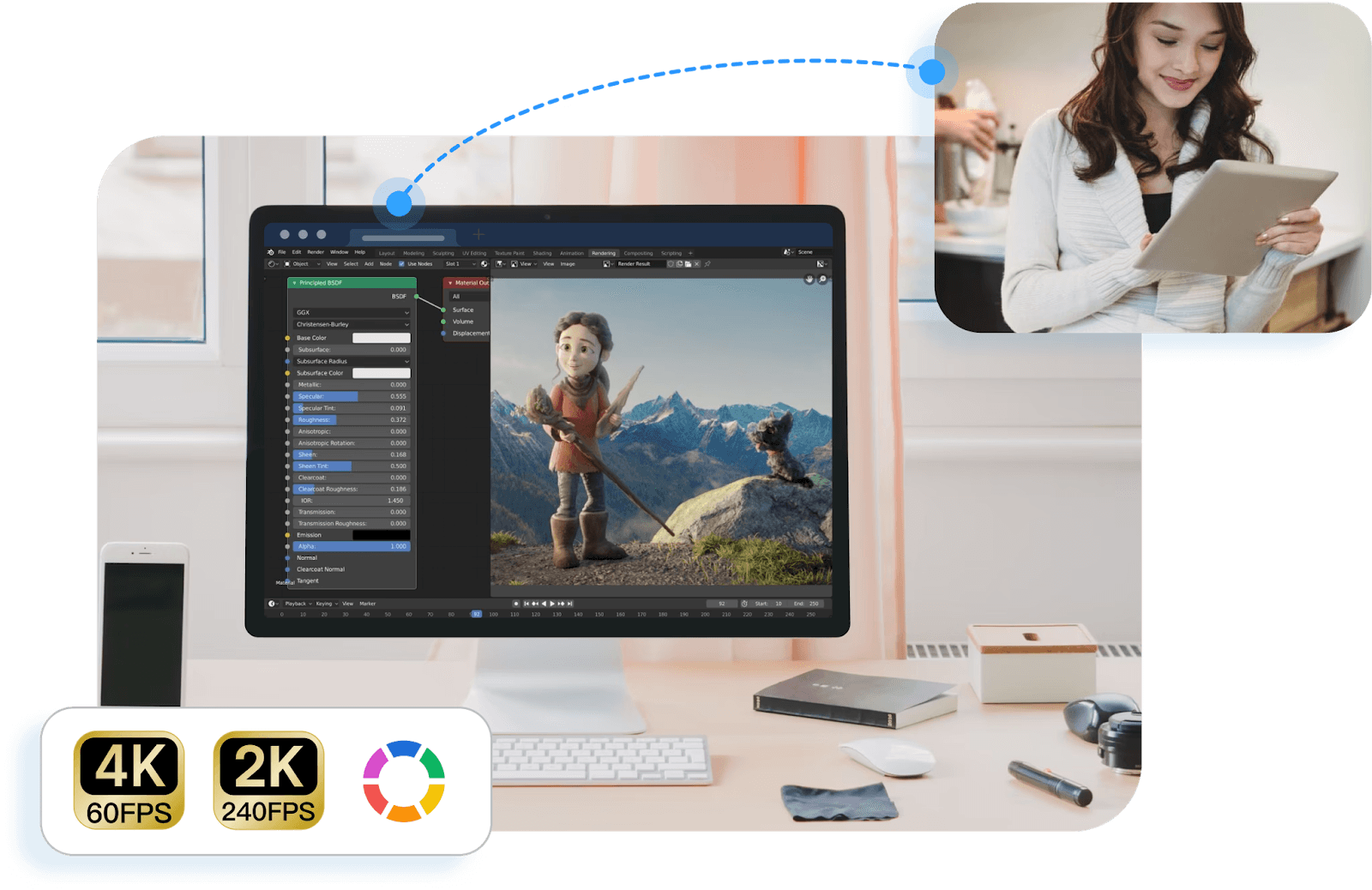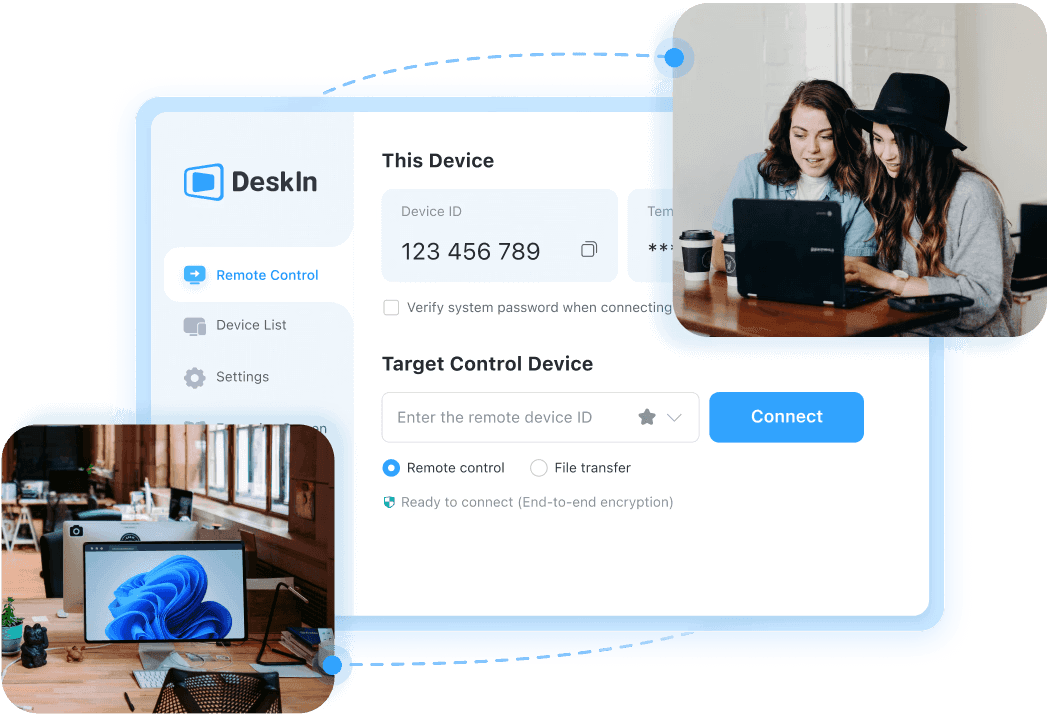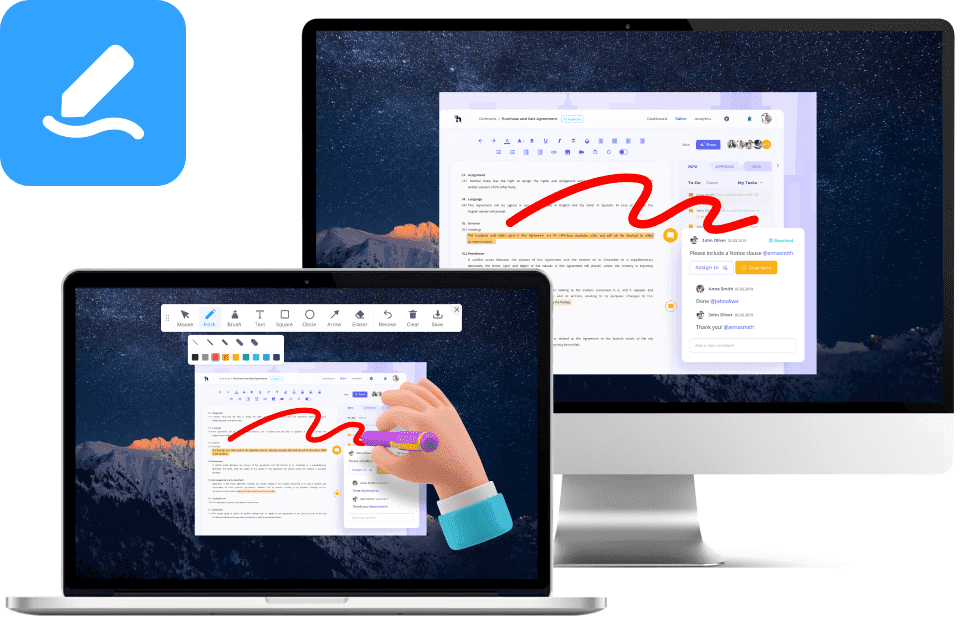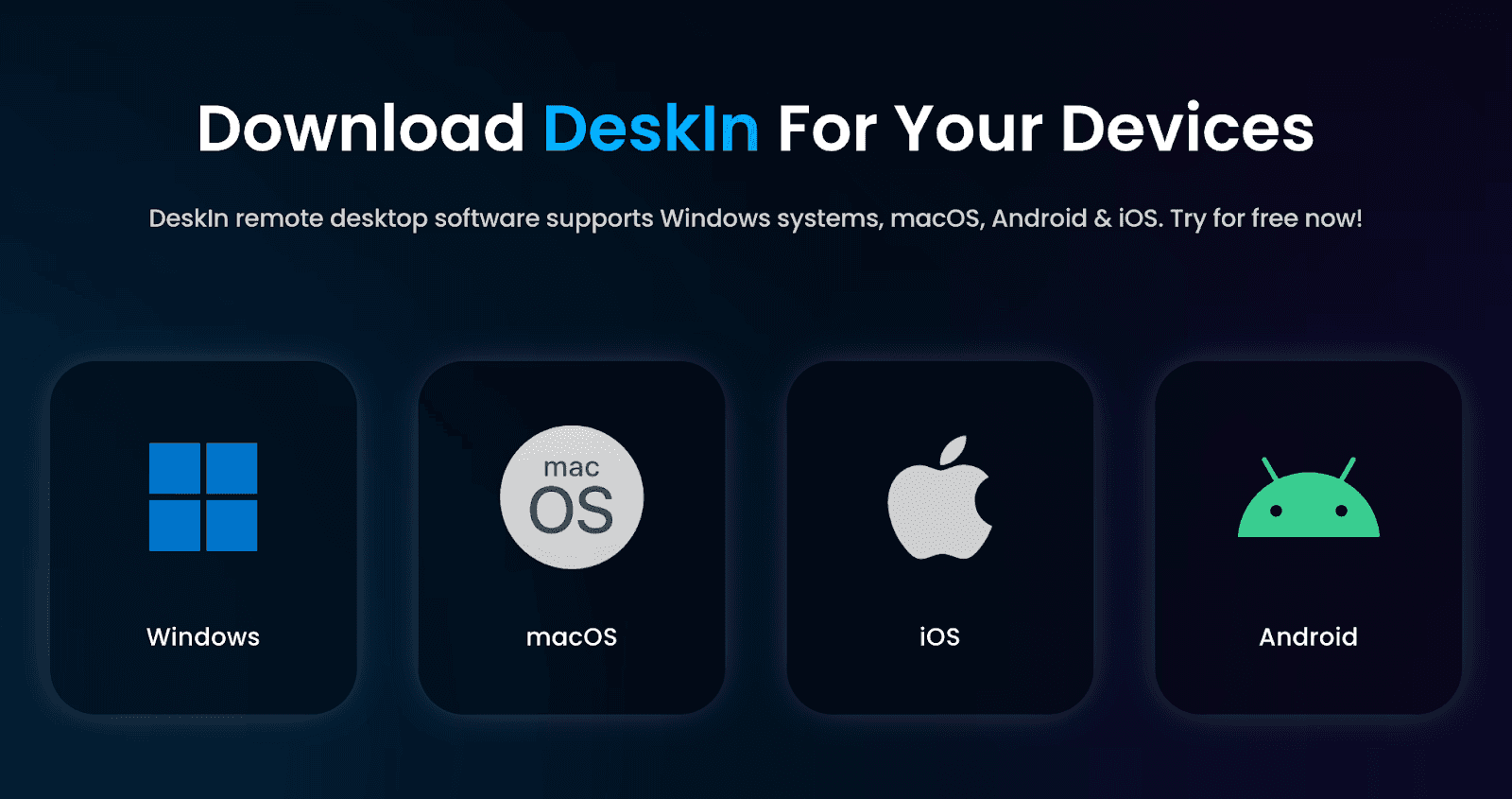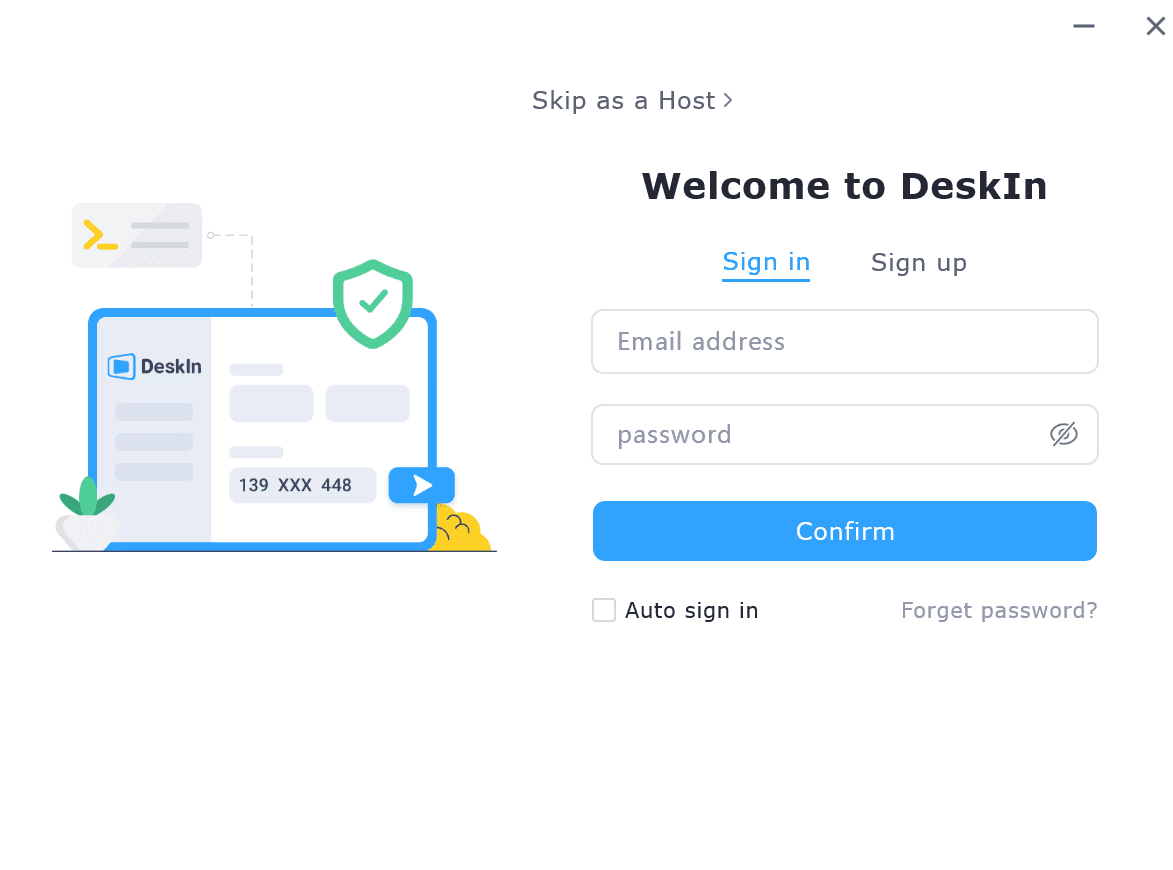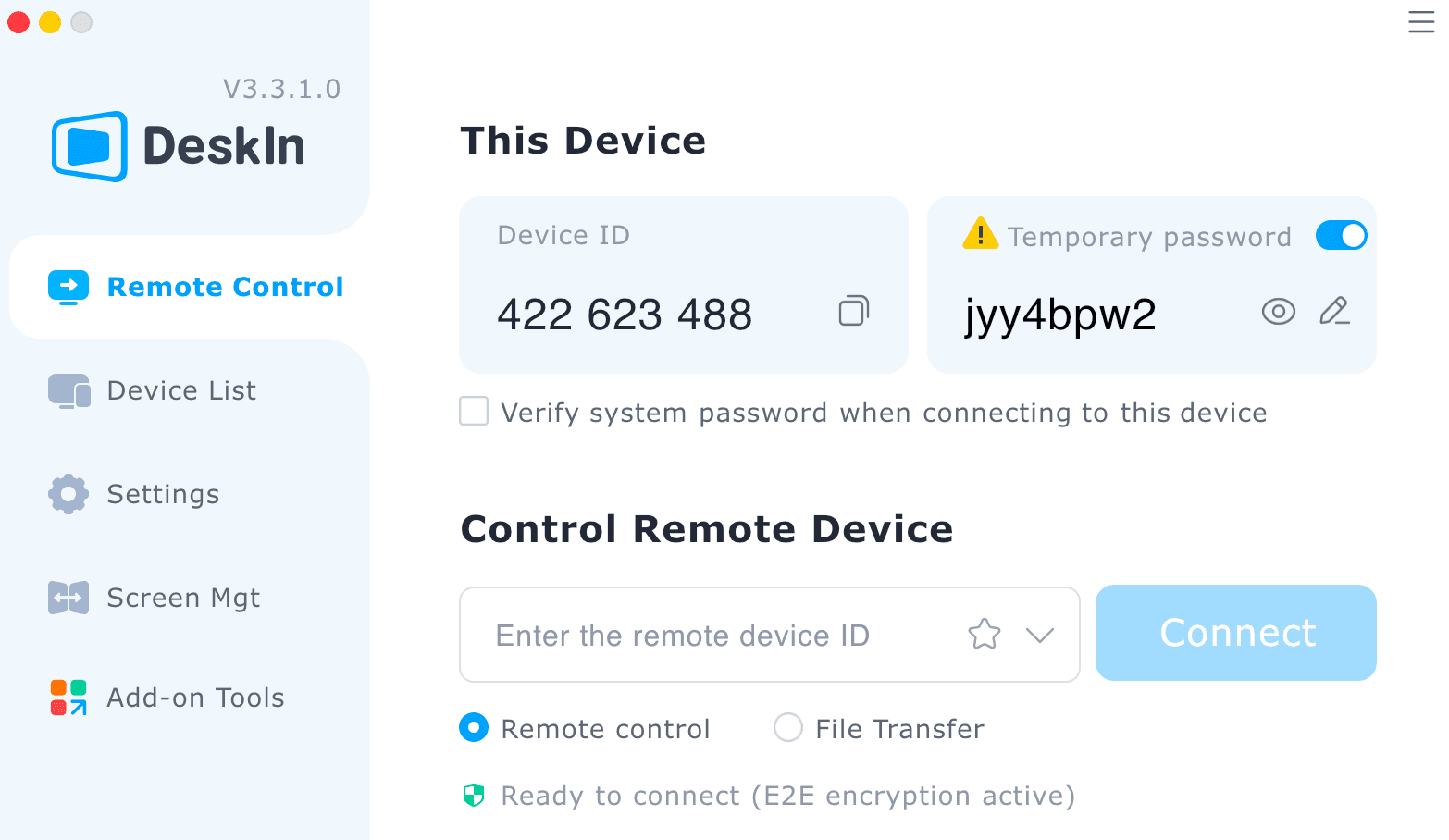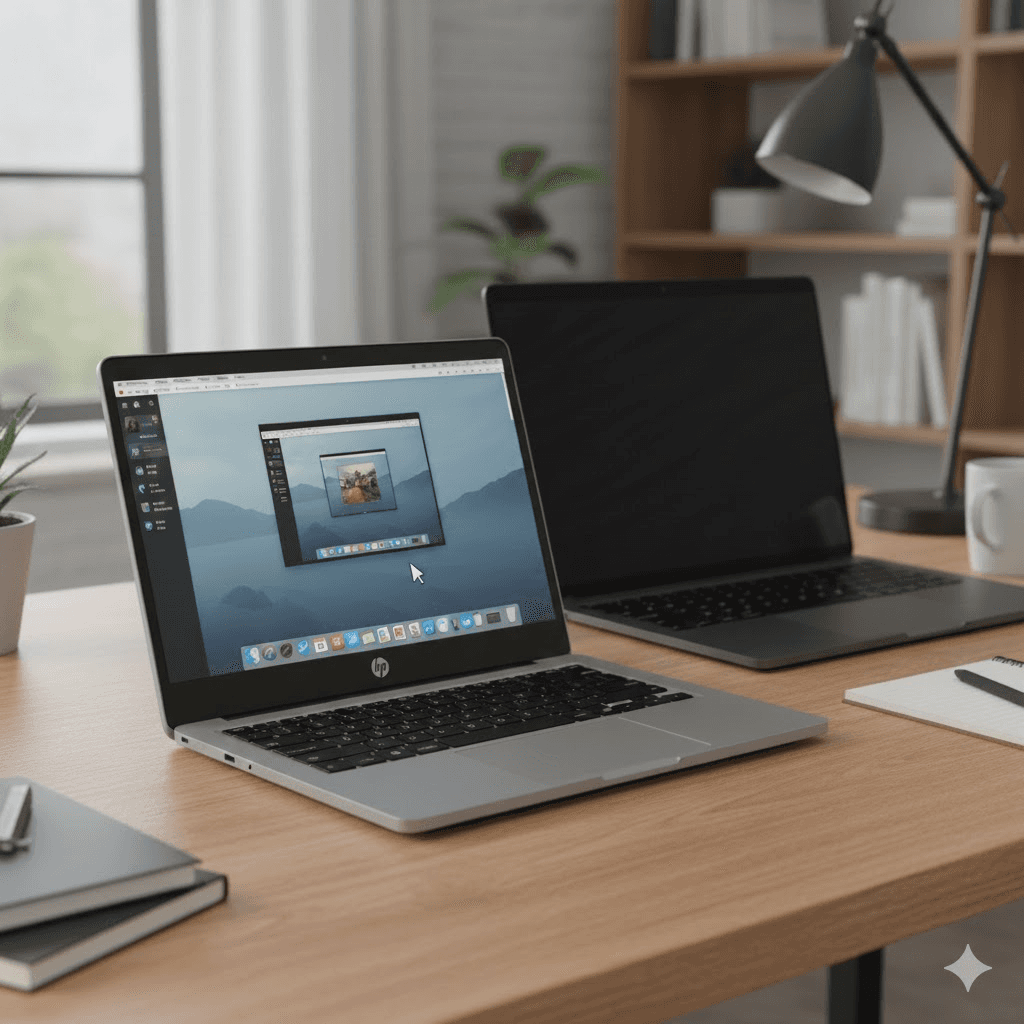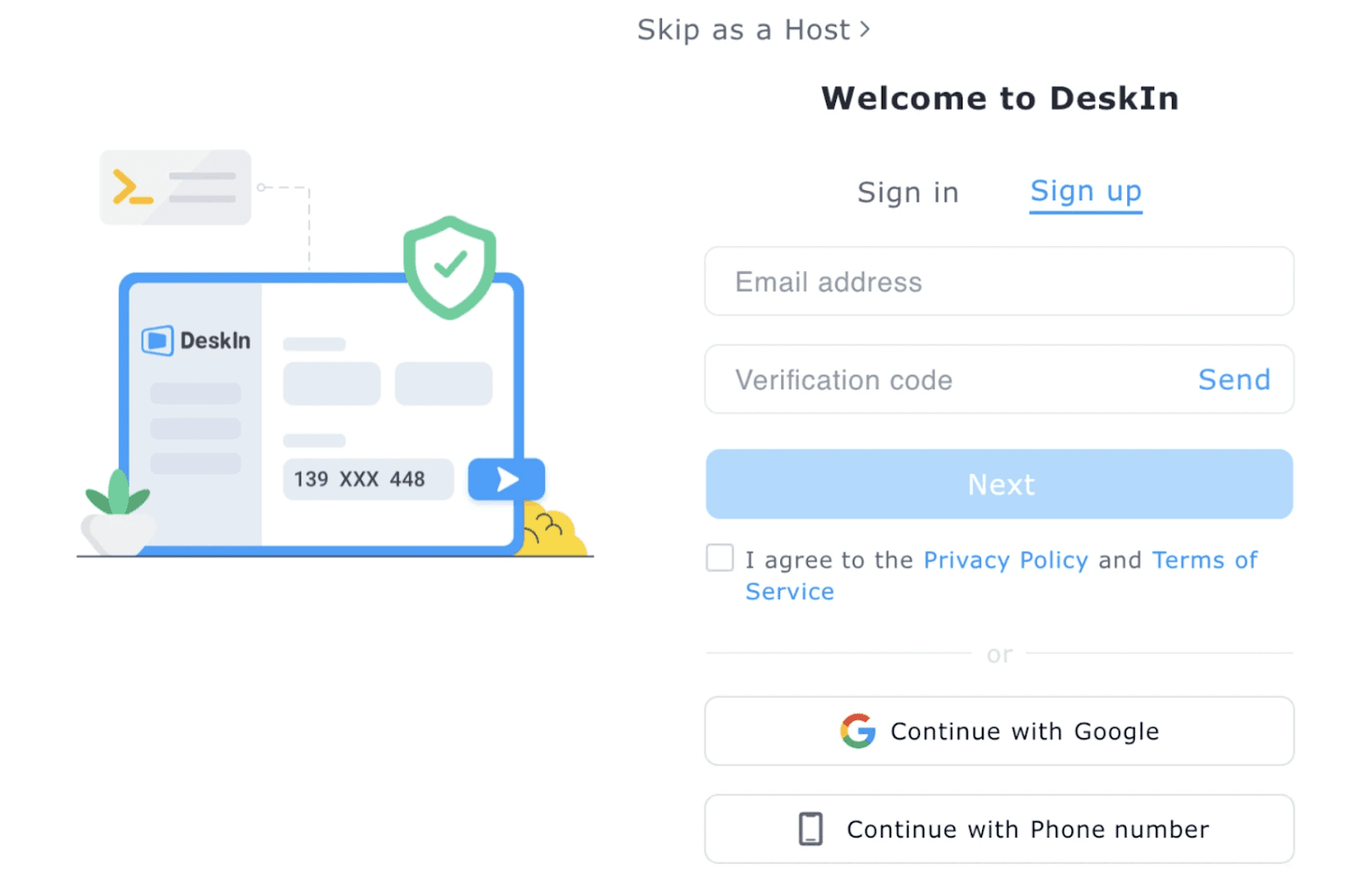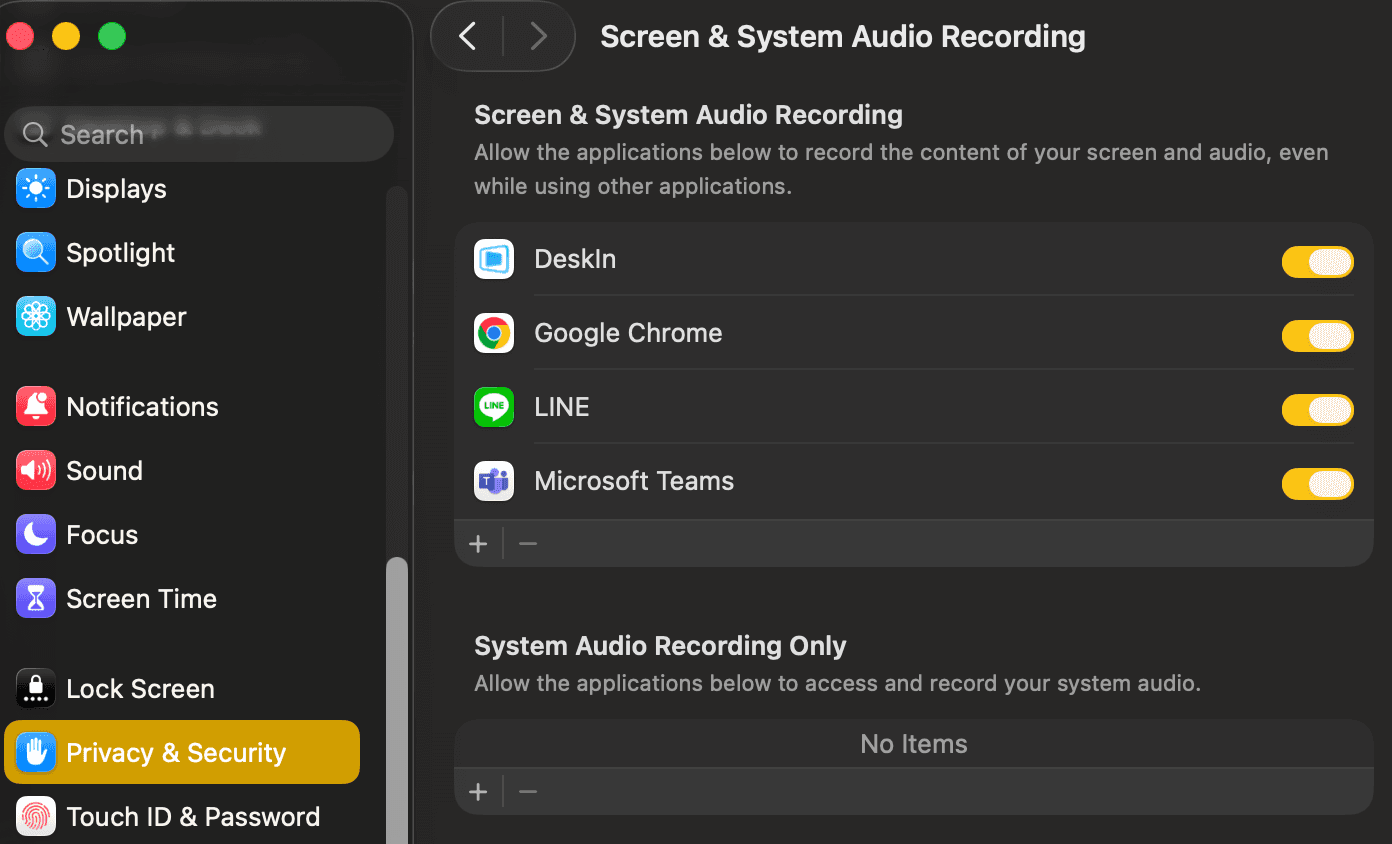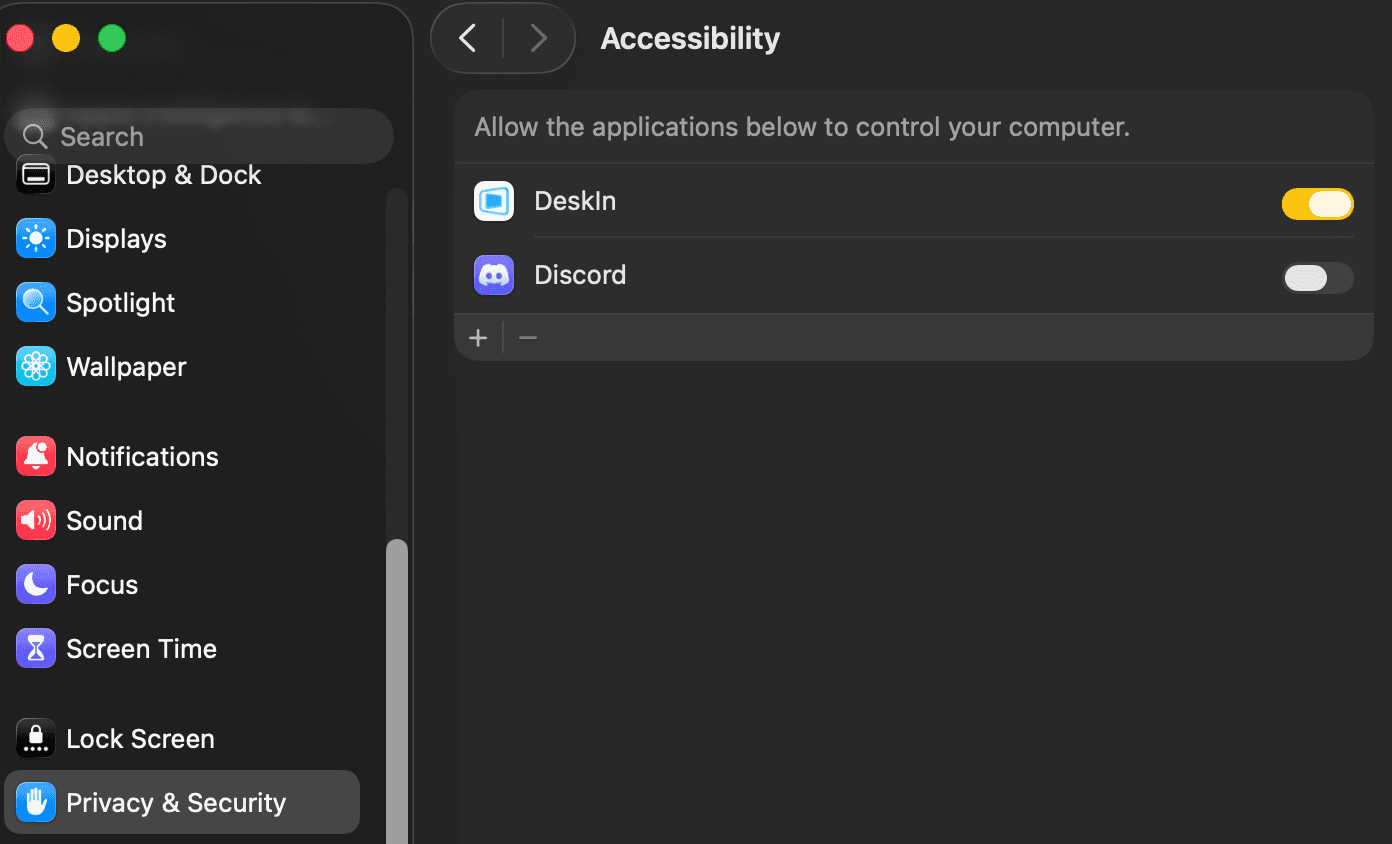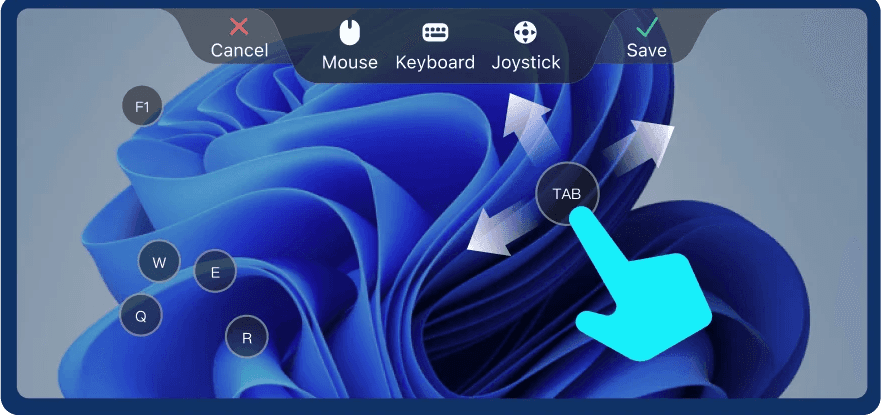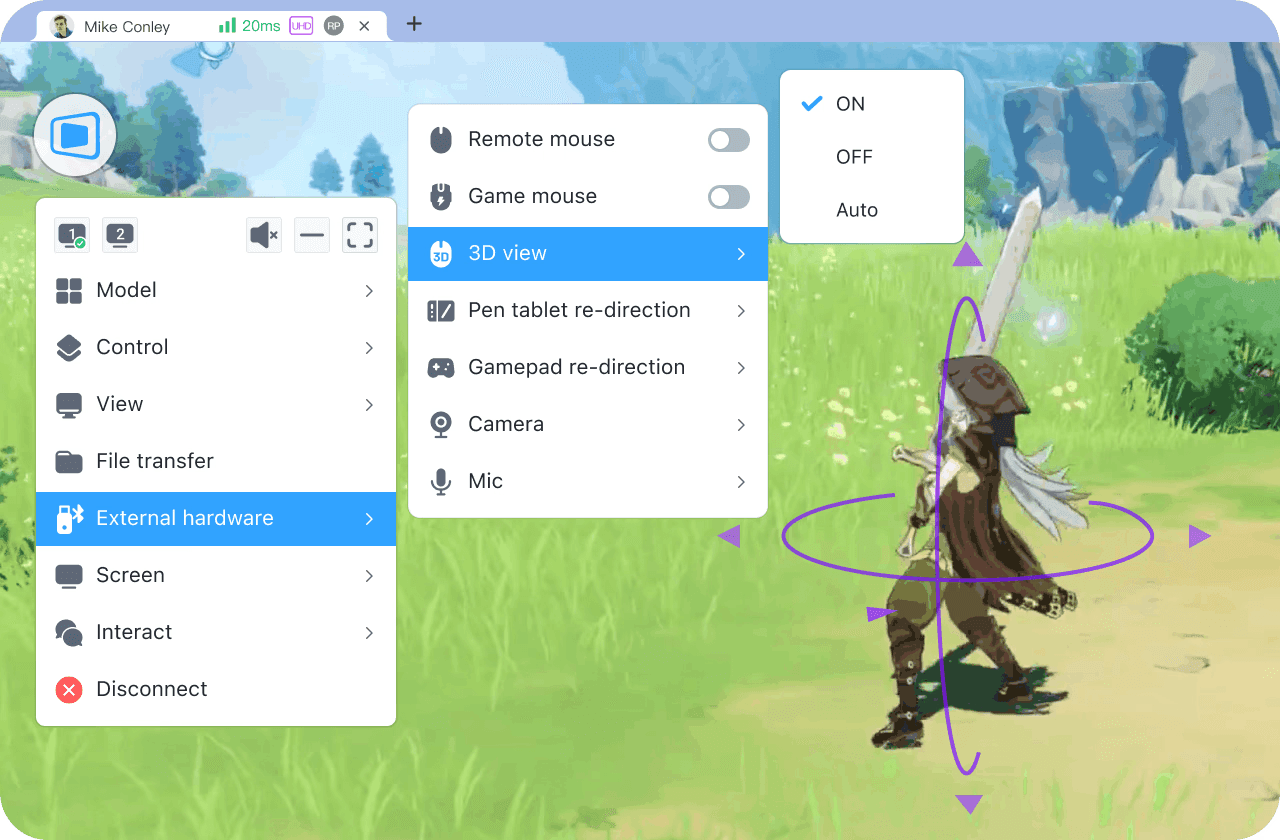Remote desktop software makes it easy to work, study, and provide support from anywhere, but it also introduces serious security risks if not properly protected. Strong encryption, two-factor authentication (2FA), and secure protocols like TLS 1.2 are essential to keep remote sessions private and prevent unauthorized access.
Now, choosing secure remote desktop software is more important than ever. In this article, we review five of the best secure remote desktop options, including trusted products and a standout newcomer, DeskIn, offering a powerful balance of security, performance, and value.
👉 Click here to download DeskIn
You May Like:
Best 3 Free Remote Desktop Software [Feature Comparison]
Top 10 Remote Desktop Software Options For 2025 [Review]
1. DeskIn: Best Remote Desktop Feature-full App
DeskIn offers a rare combination of strong security, high performance, and excellent value. It's an ideal choice as the best free secure remote desktop for Windows/Mac, without sacrificing quality. DeskIn's security features include mandatory email verification for new registrations and device logins, a privacy screen function to protect on-screen activities during remote sessions, and customizable device blacklists and whitelists for granular access control. These features create secure remote desktop access for personal and professional use.
On the performance side, DeskIn stands out with low-latency connections, a global network of over 200 nodes, and no time restrictions on remote sessions, making it highly reliable for long hours of work or gaming. It also supports high-quality remote gaming (up to 4K 60FPS), file transfers without size limits, and seamless multi-device access across Windows, macOS, iOS, and Android. These capabilities make DeskIn a top pick for users who demand security and smooth, lag-free performance.
👉 Click here to download DeskIn

Here is a brief operation guide for you to use DeskIn to make your remote control process easy and safe.
Step 1. Go to the DeskIn official website, download the app for your platform (Windows, macOS, iOS, or Android), and complete the installation process.
Step 2. Sign up for a free account and complete the email verification step to ensure account security. You'll need to verify any new device you connect to later as well.
Step 3. Log in on both devices, link them using the device ID and password on the target device. Once connected, you can start secure, low-latency remote access right away.
💡 Pros:
Strong multi-layered security (email verification, privacy screen, access lists): When the screen privacy mode is turned on, the screen content will be hidden and not visible to anyone who has physical contact with remote devices. Access lists help you avoid any suspicious person stealing remote sessions.
Supports 4K 60FPS remote gaming and high-fidelity design work
Low latency with over 200 global nodes
No time limits on remote sessions
The free plan supports up to three devices commercially
Cons:
Advanced features (e.g., 100+ device control) require an upgrade to paid plans.
2. Microsoft Remote Desktop: Built-in Tool for Seamlessly Remote Access

As a built-in, free secure remote desktop software, it's tailored for you managing Windows ecosystems. Microsoft Remote Desktop, called Windows App, employs robust encryption to reasonably protect communications, though weak passwords remain vulnerable to brute-force attacks.
Pros:
Features rigorous encryption and protection mechanisms
Free built-in tool requiring no additional installation
Cons:
Usernames/passwords susceptible to brute-force attacks
Less ideal for teams needing military-grade security or handling complex network configurations
You May Also Need:
How to Use Microsoft Remote Desktop on Windows 11 (Full Guide)
How to Enable Remote Desktop Windows 10 with Ease
3. Chrome Remote Desktop: Free Solution for Casual Users
Chrome Remote Desktop offers a secure and straightforward way to remotely access devices through your Google account. It leverages Google's built-in security features, including mandatory two-factor authentication (2FA) if enabled on your account, and encrypts all remote sessions end-to-end. This makes it a solid choice for users who want a basic but secure remote desktop solution without complicated setups.
Best suited for light remote access needs, Chrome Remote Desktop excels in simplicity and ease of use. It's completely free, works across platforms, and requires no additional software beyond a browser extension. However, its functionality is limited compared to professional remote desktop tools, making it less ideal for business or advanced technical use.

💡 Pros:
Google account 2FA and encrypted connections
Completely free to use
Easy setup and intuitive interface
Cross-platform compatibility (Windows, macOS, Linux, Android, iOS)
Minimal resource usage, not taking up much computer memory space
Cons:
Limited features (no file transfer, no multi-monitor support)
Not suitable for heavy or enterprise-level remote work
Relies heavily on Google account security
Performance issues on slower internet connections
4. HelpWire: Most Easy to Use Tool for Remote Control

This zero-registration remote desktop solution offers exceptional simplicity for both free personal and commercial use. HelpWire implements enterprise-grade encryption standards and highly reliable authentication methods to secure all remote connections, making security effortless for you.
Pros:
Integrated Auth0 platform safeguards credentials (used by Siemens and other major brands)
TLS/SSL protocols with AES-256 encryption ensure data security
Eliminates risky RDP port forwarding through standard data protocols
Cons:
Lacks mobile support for on-the-go access
No paid plans mean missing advanced features like self-hosting
About RDP risky port, read our What is RDP Security to learn more.
5. Parsec: Fastest Secure Remote Desktop Software

We recommend this high-performance remote desktop support software for its ultra-low latency delivering smooth 60fps 4K streaming—perfect for remote gaming. Your data transfers directly peer-to-peer, inaccessible to third parties. Identity verification uses IP addresses/emails, with static data secured by AES-256 encryption and transmissions protected by TLSv1.2+ protocols.
Pros:
Peer-to-peer data transfer ensures complete privacy (no third-party access)
Ultra-low latency enables seamless 60fps 4K experiences
Cons:
Setup complexity challenges new users
Inefficient device-to-device session transfers
6. Supremo: User-friendly Secure Remote Desktop Software
With its intuitive interface and streamlined setup, this free remote desktop tool shines when guiding others through phone-assisted installations. We find it exceptionally user-friendly while maintaining robust security across desktop and mobile devices—delivering consistently smooth remote sessions.

Pros:
Custom IP filters block/allow specific addresses + mandatory connection passwords
Extremely simple setup process ideal for non-technical users
Cons:
Frequent scam attempts (fake support teams/malicious clones)
Unstable chat functionality causes crashes and lag
7. RustDesk: Free App for Mobile Remote Access
As a free, open-source secure remote desktop connection software, RustDesk empowers you with self-hosted servers ensuring complete data sovereignty. It has been designed its built-in network configuration and server setup to make on-premise deployment both effortless and reliably secure—putting privacy control firmly in your hands.

Pros:
End-to-End Encryption (NaCl-based) + self-hosting guarantees data sovereignty and enhanced privacy control
Free open-source tool with diverse customization (branding, 90+ configs)
Support multi-platform like, Windows, macOS, Linux, Android
Cons:
Self-hosting complexity challenges non-technical users
8. AnyDesk: Lightweight and Highly Secure Option
AnyDesk has built a strong reputation as one of the fastest and most secure remote desktop tools available today. It leverages robust security measures such as TLS 1.2 encryption, RSA 2048 asymmetric key exchange, and optional two-factor authentication (2FA), making it a solid choice for businesses and individuals who prioritize secure connections. These features ensure that all session data remains encrypted and protected from unauthorized access.
In terms of performance, AnyDesk delivers smooth and responsive remote control, thanks to its lightweight client and proprietary DeskRT codec. Its clean user interface and fast connection speeds make it ideal for quick troubleshooting, IT support, or accessing workstations remotely. However, while the free version is functional, its commercial usage restrictions and limited features can be a drawback for professional users.

💡 Pros:
End-to-end encrypted sessions with TLS 1.2 and RSA 2048
Very low latency and high responsiveness
Lightweight and easy to install
Cross-platform support (Windows, macOS, Linux, iOS, Android)
Custom branding options for enterprise users
Cons:
Free version not licensed for commercial use
Some advanced features are locked behind paid plans
May require manual firewall or permission configurations for full functionality
Occasional performance drops in more complex or high-demand environments
9. Splashtop: Secure Remote Access for Businesses and Teams
Splashtop is a powerful remote desktop solution designed with security at its core. It uses robust device authentication, TLS, and 256-bit AES session encryption to protect remote connections against unauthorized access. Two-factor authentication (2FA) is also available, providing an extra layer of protection for users managing sensitive data or remote infrastructure.
Beyond security, Splashtop stands out for its enterprise-focused features, including user management, granular access control, session recording, and integration with single sign-on (SSO) providers. It's particularly popular among IT teams and organizations that require large-scale deployment and strong compliance support. However, for individual users or smaller teams, Splashtop's pricing can feel steep compared to more flexible alternatives.

💡 Pros:
Strong device authentication and session encryption (TLS, AES-256)
Two-factor authentication (2FA) support
Detailed user management and session control
SSO integration for enterprise users
High performance with minimal latency
Cons:
Higher pricing compared to consumer-focused options
Some features are locked behind business-oriented plans
Limited appeal for casual or solo users
Interface complexity is hard for those new to remote desktop solutions
10. TeamViewer: Best for Large Enterprises
TeamViewer has long been recognized as one of the most secure and reliable remote desktop solutions on the market. It implements 256-bit AES encryption for all sessions, enforces two-factor authentication (2FA) for account security, and holds SOC2 certification, which verifies its commitment to strict data protection and privacy standards. These measures make TeamViewer an excellent choice for businesses and users who prioritize high-level security in their remote connections.
Designed for scalability, TeamViewer is particularly suitable for large-scale organizations that require centralized device management, comprehensive user controls, and support for cross-platform connectivity. However, its licensing costs are relatively high, which can be a drawback for small teams or individual users looking for more affordable solutions.

💡 Pros:
256-bit AES encryption and strong security compliance (SOC2)
Two-factor authentication (2FA) and device management
Highly scalable for enterprise use
Supports a wide range of operating systems and devices
Advanced features like remote monitoring and patch management
Cons:
High licensing fees for professional and enterprise plans
Occasional false positives on "commercial use" warnings for free users
Some advanced features can feel overly complex for casual users
Get wrong while using without reasons
More recommended tools:
mRemoteNG: An open-source software suitable for system administrators and IT professionals
ISL Online: offers a self-hosted plan, and transparent pricing, suitable for freelancers, SMBs, and large corporations
RemotePC: Its business plans cost much less than the competition and it's top remote access solution for small teams
Tips: Best Way to Secure Remote Desktop Connections
Before wrapping up, it's crucial to understand that even the best secure remote desktop software still relies on users following good security practices. Here are a few essential tips to maximize your protection:
Enable firewall protection on both local and remote devices to control incoming and outgoing traffic.
Use strong, unique passwords for all remote accounts and sessions to prevent brute-force attacks.
Activate two-factor authentication (2FA) wherever available to add an extra verification step beyond your password.
Keep software updated regularly to ensure you're protected against the latest vulnerabilities and exploits.
Limit user permissions and review remote session logs to spot any unusual activity early.
When choosing the most secure remote desktop software, always align your selection with your specific needs.
For personal use or light tasks, free and simple options like Chrome Remote Desktop work well.
Businesses and teams should prioritize enterprise-grade solutions like Splashtop or TeamViewer that offer user management and compliance support.
If you're a gamer, designer, or student, you'll benefit most from a solution like DeskIn, which delivers a unique balance of performance, security, and affordability.
👉 Click here to download DeskIn
Conclusion: Which Secure Remote Desktop is Best for You?
Choosing the right secure remote desktop software depends on your specific needs, whether it's for casual personal use, professional work, gaming, or enterprise operations. If you are looking for a modern, affordable, and highly secure remote desktop solution, DeskIn stands out.
It combines strong security measures with excellent performance and an unbeatable price point, perfect for students, professionals, gamers, and creative designers alike. Ready to experience next-level secure remote access? Hit the button below to try DeskIn and enjoy a smooth, secure remote connection wherever you are!
Remote desktop software makes it easy to work, study, and provide support from anywhere, but it also introduces serious security risks if not properly protected. Strong encryption, two-factor authentication (2FA), and secure protocols like TLS 1.2 are essential to keep remote sessions private and prevent unauthorized access.
Now, choosing secure remote desktop software is more important than ever. In this article, we review five of the best secure remote desktop options, including trusted products and a standout newcomer, DeskIn, offering a powerful balance of security, performance, and value.
👉 Click here to download DeskIn
You May Like:
Best 3 Free Remote Desktop Software [Feature Comparison]
Top 10 Remote Desktop Software Options For 2025 [Review]
1. DeskIn: Best Remote Desktop Feature-full App
DeskIn offers a rare combination of strong security, high performance, and excellent value. It's an ideal choice as the best free secure remote desktop for Windows/Mac, without sacrificing quality. DeskIn's security features include mandatory email verification for new registrations and device logins, a privacy screen function to protect on-screen activities during remote sessions, and customizable device blacklists and whitelists for granular access control. These features create secure remote desktop access for personal and professional use.
On the performance side, DeskIn stands out with low-latency connections, a global network of over 200 nodes, and no time restrictions on remote sessions, making it highly reliable for long hours of work or gaming. It also supports high-quality remote gaming (up to 4K 60FPS), file transfers without size limits, and seamless multi-device access across Windows, macOS, iOS, and Android. These capabilities make DeskIn a top pick for users who demand security and smooth, lag-free performance.
👉 Click here to download DeskIn

Here is a brief operation guide for you to use DeskIn to make your remote control process easy and safe.
Step 1. Go to the DeskIn official website, download the app for your platform (Windows, macOS, iOS, or Android), and complete the installation process.
Step 2. Sign up for a free account and complete the email verification step to ensure account security. You'll need to verify any new device you connect to later as well.
Step 3. Log in on both devices, link them using the device ID and password on the target device. Once connected, you can start secure, low-latency remote access right away.
💡 Pros:
Strong multi-layered security (email verification, privacy screen, access lists): When the screen privacy mode is turned on, the screen content will be hidden and not visible to anyone who has physical contact with remote devices. Access lists help you avoid any suspicious person stealing remote sessions.
Supports 4K 60FPS remote gaming and high-fidelity design work
Low latency with over 200 global nodes
No time limits on remote sessions
The free plan supports up to three devices commercially
Cons:
Advanced features (e.g., 100+ device control) require an upgrade to paid plans.
2. Microsoft Remote Desktop: Built-in Tool for Seamlessly Remote Access

As a built-in, free secure remote desktop software, it's tailored for you managing Windows ecosystems. Microsoft Remote Desktop, called Windows App, employs robust encryption to reasonably protect communications, though weak passwords remain vulnerable to brute-force attacks.
Pros:
Features rigorous encryption and protection mechanisms
Free built-in tool requiring no additional installation
Cons:
Usernames/passwords susceptible to brute-force attacks
Less ideal for teams needing military-grade security or handling complex network configurations
You May Also Need:
How to Use Microsoft Remote Desktop on Windows 11 (Full Guide)
How to Enable Remote Desktop Windows 10 with Ease
3. Chrome Remote Desktop: Free Solution for Casual Users
Chrome Remote Desktop offers a secure and straightforward way to remotely access devices through your Google account. It leverages Google's built-in security features, including mandatory two-factor authentication (2FA) if enabled on your account, and encrypts all remote sessions end-to-end. This makes it a solid choice for users who want a basic but secure remote desktop solution without complicated setups.
Best suited for light remote access needs, Chrome Remote Desktop excels in simplicity and ease of use. It's completely free, works across platforms, and requires no additional software beyond a browser extension. However, its functionality is limited compared to professional remote desktop tools, making it less ideal for business or advanced technical use.

💡 Pros:
Google account 2FA and encrypted connections
Completely free to use
Easy setup and intuitive interface
Cross-platform compatibility (Windows, macOS, Linux, Android, iOS)
Minimal resource usage, not taking up much computer memory space
Cons:
Limited features (no file transfer, no multi-monitor support)
Not suitable for heavy or enterprise-level remote work
Relies heavily on Google account security
Performance issues on slower internet connections
4. HelpWire: Most Easy to Use Tool for Remote Control

This zero-registration remote desktop solution offers exceptional simplicity for both free personal and commercial use. HelpWire implements enterprise-grade encryption standards and highly reliable authentication methods to secure all remote connections, making security effortless for you.
Pros:
Integrated Auth0 platform safeguards credentials (used by Siemens and other major brands)
TLS/SSL protocols with AES-256 encryption ensure data security
Eliminates risky RDP port forwarding through standard data protocols
Cons:
Lacks mobile support for on-the-go access
No paid plans mean missing advanced features like self-hosting
About RDP risky port, read our What is RDP Security to learn more.
5. Parsec: Fastest Secure Remote Desktop Software

We recommend this high-performance remote desktop support software for its ultra-low latency delivering smooth 60fps 4K streaming—perfect for remote gaming. Your data transfers directly peer-to-peer, inaccessible to third parties. Identity verification uses IP addresses/emails, with static data secured by AES-256 encryption and transmissions protected by TLSv1.2+ protocols.
Pros:
Peer-to-peer data transfer ensures complete privacy (no third-party access)
Ultra-low latency enables seamless 60fps 4K experiences
Cons:
Setup complexity challenges new users
Inefficient device-to-device session transfers
6. Supremo: User-friendly Secure Remote Desktop Software
With its intuitive interface and streamlined setup, this free remote desktop tool shines when guiding others through phone-assisted installations. We find it exceptionally user-friendly while maintaining robust security across desktop and mobile devices—delivering consistently smooth remote sessions.

Pros:
Custom IP filters block/allow specific addresses + mandatory connection passwords
Extremely simple setup process ideal for non-technical users
Cons:
Frequent scam attempts (fake support teams/malicious clones)
Unstable chat functionality causes crashes and lag
7. RustDesk: Free App for Mobile Remote Access
As a free, open-source secure remote desktop connection software, RustDesk empowers you with self-hosted servers ensuring complete data sovereignty. It has been designed its built-in network configuration and server setup to make on-premise deployment both effortless and reliably secure—putting privacy control firmly in your hands.

Pros:
End-to-End Encryption (NaCl-based) + self-hosting guarantees data sovereignty and enhanced privacy control
Free open-source tool with diverse customization (branding, 90+ configs)
Support multi-platform like, Windows, macOS, Linux, Android
Cons:
Self-hosting complexity challenges non-technical users
8. AnyDesk: Lightweight and Highly Secure Option
AnyDesk has built a strong reputation as one of the fastest and most secure remote desktop tools available today. It leverages robust security measures such as TLS 1.2 encryption, RSA 2048 asymmetric key exchange, and optional two-factor authentication (2FA), making it a solid choice for businesses and individuals who prioritize secure connections. These features ensure that all session data remains encrypted and protected from unauthorized access.
In terms of performance, AnyDesk delivers smooth and responsive remote control, thanks to its lightweight client and proprietary DeskRT codec. Its clean user interface and fast connection speeds make it ideal for quick troubleshooting, IT support, or accessing workstations remotely. However, while the free version is functional, its commercial usage restrictions and limited features can be a drawback for professional users.

💡 Pros:
End-to-end encrypted sessions with TLS 1.2 and RSA 2048
Very low latency and high responsiveness
Lightweight and easy to install
Cross-platform support (Windows, macOS, Linux, iOS, Android)
Custom branding options for enterprise users
Cons:
Free version not licensed for commercial use
Some advanced features are locked behind paid plans
May require manual firewall or permission configurations for full functionality
Occasional performance drops in more complex or high-demand environments
9. Splashtop: Secure Remote Access for Businesses and Teams
Splashtop is a powerful remote desktop solution designed with security at its core. It uses robust device authentication, TLS, and 256-bit AES session encryption to protect remote connections against unauthorized access. Two-factor authentication (2FA) is also available, providing an extra layer of protection for users managing sensitive data or remote infrastructure.
Beyond security, Splashtop stands out for its enterprise-focused features, including user management, granular access control, session recording, and integration with single sign-on (SSO) providers. It's particularly popular among IT teams and organizations that require large-scale deployment and strong compliance support. However, for individual users or smaller teams, Splashtop's pricing can feel steep compared to more flexible alternatives.

💡 Pros:
Strong device authentication and session encryption (TLS, AES-256)
Two-factor authentication (2FA) support
Detailed user management and session control
SSO integration for enterprise users
High performance with minimal latency
Cons:
Higher pricing compared to consumer-focused options
Some features are locked behind business-oriented plans
Limited appeal for casual or solo users
Interface complexity is hard for those new to remote desktop solutions
10. TeamViewer: Best for Large Enterprises
TeamViewer has long been recognized as one of the most secure and reliable remote desktop solutions on the market. It implements 256-bit AES encryption for all sessions, enforces two-factor authentication (2FA) for account security, and holds SOC2 certification, which verifies its commitment to strict data protection and privacy standards. These measures make TeamViewer an excellent choice for businesses and users who prioritize high-level security in their remote connections.
Designed for scalability, TeamViewer is particularly suitable for large-scale organizations that require centralized device management, comprehensive user controls, and support for cross-platform connectivity. However, its licensing costs are relatively high, which can be a drawback for small teams or individual users looking for more affordable solutions.

💡 Pros:
256-bit AES encryption and strong security compliance (SOC2)
Two-factor authentication (2FA) and device management
Highly scalable for enterprise use
Supports a wide range of operating systems and devices
Advanced features like remote monitoring and patch management
Cons:
High licensing fees for professional and enterprise plans
Occasional false positives on "commercial use" warnings for free users
Some advanced features can feel overly complex for casual users
Get wrong while using without reasons
More recommended tools:
mRemoteNG: An open-source software suitable for system administrators and IT professionals
ISL Online: offers a self-hosted plan, and transparent pricing, suitable for freelancers, SMBs, and large corporations
RemotePC: Its business plans cost much less than the competition and it's top remote access solution for small teams
Tips: Best Way to Secure Remote Desktop Connections
Before wrapping up, it's crucial to understand that even the best secure remote desktop software still relies on users following good security practices. Here are a few essential tips to maximize your protection:
Enable firewall protection on both local and remote devices to control incoming and outgoing traffic.
Use strong, unique passwords for all remote accounts and sessions to prevent brute-force attacks.
Activate two-factor authentication (2FA) wherever available to add an extra verification step beyond your password.
Keep software updated regularly to ensure you're protected against the latest vulnerabilities and exploits.
Limit user permissions and review remote session logs to spot any unusual activity early.
When choosing the most secure remote desktop software, always align your selection with your specific needs.
For personal use or light tasks, free and simple options like Chrome Remote Desktop work well.
Businesses and teams should prioritize enterprise-grade solutions like Splashtop or TeamViewer that offer user management and compliance support.
If you're a gamer, designer, or student, you'll benefit most from a solution like DeskIn, which delivers a unique balance of performance, security, and affordability.
👉 Click here to download DeskIn
Conclusion: Which Secure Remote Desktop is Best for You?
Choosing the right secure remote desktop software depends on your specific needs, whether it's for casual personal use, professional work, gaming, or enterprise operations. If you are looking for a modern, affordable, and highly secure remote desktop solution, DeskIn stands out.
It combines strong security measures with excellent performance and an unbeatable price point, perfect for students, professionals, gamers, and creative designers alike. Ready to experience next-level secure remote access? Hit the button below to try DeskIn and enjoy a smooth, secure remote connection wherever you are!



![Top 5 Best Secure Remote Desktop Software Options [2025]](https://framerusercontent.com/images/LRyAO4hNfQ65qAYxBKlfoNGn9Io.jpg?width=1920&height=1080)


